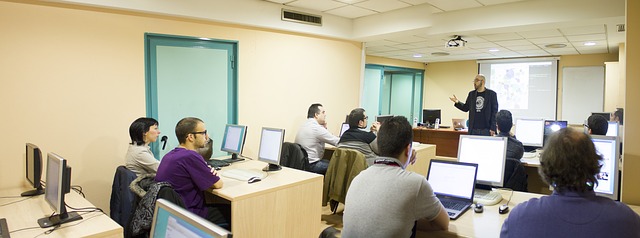Redesigning the classroom to make learning a more interactive endeavor is something many districts are contemplating and some have started. We started this process in 2013 when the Iowa Governor’s STEM Advisory Council challenged schools across the state to rethink the design of classrooms. Hoover High School, one of Des Moines Public Schools’ 10 high schools, applied for, and won, a $50,000 grant from the Governor’s STEM Advisory Council to redesign learning environments and reinvigorate the district’s STEM Academy. The district matched the grant, giving us $100,000 to create learning spaces that would be similar to the environments our students may encounter in college or in their future career. We overhauled three rooms — a “redesigned learning environment” or RLE, our Project Lead the Way classroom, and a math classroom. Although the three rooms serve different purposes, they all reinforce the use of collaboration and technology.
The RLE was not created for a specific teacher, but for open use by our entire school. Teachers and students alike love this room because it is reminiscent of a high-tech coffee house. Teachers sign up to use the room for specific classes, meetings or professional development or to complete lesson planning and grading. We wanted to incorporate a variety of work areas to help facilitate a small group work/stations model. We purchased high tables, plush chairs with built-in charging ports and dry-erase tables and cushioned stools. We then position some of the room’s work stations around interactive projectors. Teachers and students wirelessly connect their devices to the projector and then use finger-touch technology to draw and annotate on documents, webpages, pictures and more.
This highly collaborative, group station model enables teachers to differentiate instruction and float around to help groups as needed. For example, a geometry teacher used RLE to work on the concept of transformations. She wanted her lesson to achieve several objectives in one class period, so we helped her design different stations to meet the requirements. At one station, students used their fingers to draw and flip or rotate the geometric shape by various degrees on the interactive projector. The end result was the creation of a huge artistic piece.
The RLE has been particularly useful for preparing students to compete in The World Food Prize Foundation’s annual Iowa Youth Institute, a Nobel Prize-like student competition held at Iowa State University. Students are required to write a paper that explores an agricultural or food scarcity problem unique to a region of the world and then present their findings to professionals. In the RLE, students not only create and practice their presentation using the interactive projector; they pull up an interactive world map and zero-in on the country they are presenting about, which helps bring the classroom to that country.
Also, Hoover High School uses the RLE and a STEM BEST grant to provide career counseling for students. They use the room to videoconference with professors and connect with Iowa State University scientists. By talking with these professionals, students get a sense of what it is really like to work in STEM fields.
To redesign our Project Lead the Way Classroom, we completely renovated a room full of cubicles to create a makerspace. Students brainstorm designs around group desks and create the design using modeling and technical drawing software on desktop computers. The instructor then projects the designs via the interactive projector and leads classroom discussions. Students suggest design improvements and more using the annotation tools, and once a design is finalized, they can print out a prototype using 3D printers. Similar to the RLE and the Project Lead the Way Classroom, the updated math classroom consists of mobile desks grouped together for stations or small group work, dry-erase tabletops and an interactive projector mounted above one wall.
The redesigned classrooms, which have become the model for future classrooms, have completely changed the way our teachers teach. Replicating these rooms districtwide is a future goal, but in the meantime, our district is making strides toward incorporating more technology in our current classrooms. We have installed more than 2,000 interactive projectors across the districts’ 65 schools in the past two years and created a 3:1 device ratio for students in grades K-5 and a 2:1 ratio in grades 7-12 in the last year. Before these changes, you would most likely see a teacher at the head of the classroom with students in rows at desks. Now, you’ll see students grouped together collaboratively working on projects and deeply engaged in their studies.
Dan Warren is the director of Technology Operations, Central Stores, and Printing Services at Des Moines Public Schools, and Maureen Griffin is the science school improvement leader and STEM administrator at Hoover High School. The RLE at Hoover High features Epson interactive projectors and SMART Notebook interactive software.
____________________________________
Like this article? Sign up for Career Tech Update SmartBrief to get news like this in your inbox, or check out all of SmartBrief’s education newsletters, covering career and technical education, educational leadership, math education and more.
